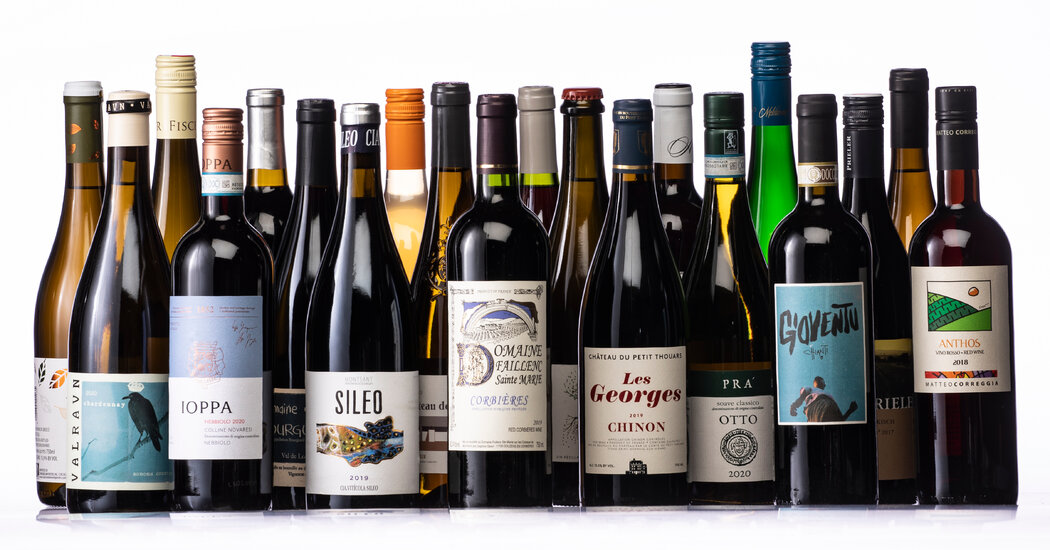These 20 wines are not from the most famous regions. But they are great values and, most important, delicious.
It’s a bleak, cold January day, and as I look out the window at a solitary, huddled figure waiting for a city bus, I want nothing more than the hot split pea soup simmering on my stove and a good bottle of wine to go with it.
“Good” is the operative word. As the Australian wine impresario Len Evans put it eloquently in what he called his “Theory of Capacity,” life is too short to waste it on inferior bottles. That is true no matter the price.
While good, distinctive wines can be found at every price, the odds of finding great values in everyday wines are most in your favor if you commit to spending $15 to $25 a bottle.
Fascinating bottles abound, and if you find one not to your taste, perhaps it can be chalked up to experience.
Recently I went on a digital shopping spree at New York wine shops, looking for great values under $20. These 20 bottles are not from the most heralded appellations, and some are made with wholly obscure grapes. The best values come from discoveries rather than from pursuing the tried-and-true.
Given the fragmented nature of American wine distribution, you will not find these 20 bottles in any single store, and probably not in any other city. But you should be able to find some of them and plenty of substitutes for those you can’t find.
Consult past 20 Under $20 columns, or ask for advice at the best wine shop near you. Good merchants can rise to the challenge of offering a good Bourgueil other than the one I suggest, or another sub-$20 California cabernet. If there’s a bottle you’ve got your heart set on and it’s gone, well, another vintage will be coming up.
This column includes the alcohol content. It can be useful, giving clues about the style of the wine, whether it may contain residual sugar, taste ripe and fruity or fall more on the austere side.
Some people, including me, consider the amount of alcohol in deciding which wine to open. A bottle at 15 percent contains 20 percent more alcohol than a bottle at 12.5 percent. As someone who likes to drink without governing sips, that’s important. And, as someone who has long advocated ingredients and processes labeling for wine, it only seemed right to offer available facts.
This list is slightly weighted toward reds, but over time I’ve found myself drinking more whites, regardless of the season, simply because of what I cook. Whoever said the first duty of a wine was to be red didn’t know what he was talking about.
Domaine Guion Bourgueil Cuvée Domaine 2019, 12.5 percent, $14.99
Compared with the many producers who have taken up organic farming in the last decade, Domaine Guion has been doing it seemingly forever, since 1965. This Bourgueil, made of cabernet franc, demonstrates how good a relatively simple wine can be when produced conscientiously. It’s pure and unmediated, with direct flavors of red and dark fruits, and a touch of well-integrated bell pepper. It’s a great drink and a superb value. (M.F.W. Wine Company, New York)
Château du Petit Thouars Chinon Les Georges 2019, 13.5 percent, $16.99
Loire reds are perennially among the best values in wine, even as other reliable bottles, like cru Beaujolais, creep up in price. This Chinon is a little more structured than the Bourgueil, with discernible chalky tannins. Yet it’s immensely likable, with earthy aromas and flavors of flowers, herbs and red fruits. (Rosenthal Wine Merchant, New York)
Melsheimer Mosel Riesling Handwerk 2020, 10.5 percent, $19.99
This excellent family estate farms biodynamically, primarily on perilously steep slopes in the Mosel Valley in Germany. Handwerk is Melsheimer’s entry-level wine, a terrific introduction to its luminous, pure, energetic rieslings. The 2020 in particular is lovely. It’s light-bodied, but full of peachy, earthy, mineral flavors and it tastes quite dry, though it has a touch of residual sugar. (M.S. Walker, Boston)
Gioventù Chianti 2019, 13 percent, $15.99
Chianti Classico is the best-known zone in the Chianti region and generally produces the highest quality wines, but the extended area also has a lot to offer. Michael Schmeltzer, the man behind the excellent Monte Bernardi Chianti Classicos, also makes this wine from organically farmed grapes grown in the greater Chianti area. It’s bright with zippy acidity, simple and easy to enjoy. (T. Edward Wines, New York)
Valravn Sonoma County Chardonnay 2020, 14.2 percent, $19.99
California chardonnay has the reputation of being extravagant, oaky and overblown, but this wine is the antithesis, subtle rather than excessive. Valravn obtains grapes from all over Sonoma. For this bottle they come from three areas: the Sonoma Coast, the Russian River Valley and the Petaluma Gap. It’s rich yet balanced, with inviting flavors of apples, herbs and sweet corn.
Gulp/Hablo Spain Verdejo/Sauvignon Blanc 2020, 11.5 percent, $19.99, 1 liter
This is an orange wine, a white made using red wine techniques. The juice of the grapes is macerated with the skins, which provide a tinge of color and a mild rasp of tannin. The grapes, half verdejo and half sauvignon blanc, are grown organically and the winemaker is the excellent Juan Antonio Ponce of Bodegas Ponce, one of the best producers in Manchuela in eastern Spain. The wine is textured and aromatic, fresh and refreshing with flavors of citrus and sauvignon blanc pungency. (T. Edward Wines)
Ultraviolet California Cabernet Sauvignon 2020, 14.5 percent, $17.99
Samantha Sheehan makes chardonnay, pinot noir and a variety of rosés under the label POE Wines. She uses the Ultraviolet label for cabernet sauvignons like this one, a pure California expression of ripe fruit that is nonetheless well balanced. This is a juicy, fresh, voluptuous wine that never goes over the top. If you like fruity California cabernets, this is an excellent bottle.
Ver Sacrum Los Chacayes — Valle de Uco Monastrell 2018, 13 percent, $19.99
This is the first time I’ve tried Ver Sacrum’s monastrell and it’s lovely, though lighter and easier-going than I would have expected. Under its French name, mourvèdre, the primary red grape of Bandol, the wines can be tannic beasts. But Ver Sacrum produces this wine with semicarbonic fermentation, a method common in Beaujolais and in many natural wines, yielding a juicy, aromatic, immediately pleasing wine. (Brazos Wine Imports, Brooklyn, N.Y.)
Domaine Faillenc Sainte Marie Corbières 2019, 14 percent, $16
Some of my favorite wines from the Languedoc region of southern France have a sort of wild, rustic quality that contrasts with the often overly polished nature of many modern wines. This Corbières is a good example of what I mean. It’s made of equal parts syrah, grenache and cinsault, a typical regional combination, and it’s lively, fruity and floral, with clear herbal notes and just enough tannins to offer a friendly bite. Perfect for a beef stew or a hearty soup. (Rosenthal Wine Merchant)
Akutain Rioja Cosecha 2018, 12.5 percent, $17.99
This is the first Rioja I’ve tried from Akutain, which farms around 16 acres in the Rioja Alta region. Cosecha means unaged, and this wine essentially was fermented in fiberglass vats and bottled, capturing the juicy immediacy of the tempranillo fruit. It’s spicy and earthy, easy to drink and deliciously refreshing. (José Pastor Selections/Llaurador Wines, Fairfax, Calif.)
Puech Redon Vin de France Pour de Vrai Pétillant Naturel 2020, 11 percent, $19.99
Puech Redon is an estate in the Languedoc region of southern France. After Cyril Cuche took over management from his father, he began farming organically in 2008. More recently, with the help of the excellent Rhône producer Éric Texier, he has begun making wine naturally, without adding sulfur dioxide, an almost universally employed stabilizer and antioxidant. This white pét-nat is made of red grapes, primarily cinsault, with 15 percent syrah. It’s tangy, easy, simple and refreshing, like biting into a piece of fresh fruit. (Louis/Dressner Selections, New York)
Matteo Correggia Brachetto Anthos Vino Rosso 2018, 13 percent, $19.99
This is a wild and unusual wine, worth trying for that reason alone. The fact that it’s delicious makes it even more worth seeking out. Brachetto is a grape and an appellation within the Piedmont region of northwestern Italy. It’s most common expression is as a lightly sweet sparkling red, but this is a still wine, fragrant with red fruit and floral aromas, light-bodied and delicious, delightful and easygoing. (Skurnik Wines, New York)
Domaine de l’Enchantoir Saumur Blanc 2019, 13 percent, $17.99
I love chenin blanc from the Loire Valley, yet the most famous appellations, like Vouvray and Savennières, are increasingly difficult to find for less than $20. Fortunately, Saumur Blanc, in the Anjou region, still offers good deals like this bottle from Domaine de l’Enchantoir, where the Brunet family farms roughly 40 acres organically. It’s inviting and richly textured yet light-bodied, with lovely floral and citrus flavors. (Skurnik Wines)
Château de Villeneuve Saumur 2020, 13 percent, $18
On the theory that you cannot have too much chenin blanc, how about another, contrasting Saumur Blanc that is likewise a great value? This dry, stony, textured wine comes from a historic estate, now run by Jean-Pierre Chevallier, whose family took it over in 1969. It is not quite as rich and fragrant as the l’Enchantoir. It is rather more precise and minerally. (Petit Pois/Sussex Wine Merchant, Moorestown, N.J.)
Domaine Douloufakis Crete Dafnios 2020, 13.9 percent, $17.99
This unusual white from Crete is made entirely of the vidiano grape, an indigenous variety that had practically disappeared until producers like Douloufakis helped to revive it. This is a fascinating wine, rich and extremely floral and herbal, yet light-bodied despite the alcohol level. I would serve it with sautéed fish like sole or flounder. (Diamond Importers, Chicago)
Josef Fischer Wachau Riesling Federspiel Ried Kirnberg 2019, 12.5 percent, $19.99
This Austrian riesling, compared with the Melsheimer, is bone dry, not particularly complex and more austere, with deliciously stony flavors. Federspiel is the term used in the Wachau region for grapes that are harvested at a midlevel of ripeness — more so than steinfeder, a lower level, but not as ripe as smaragd, which indicates the richest Wachau wines. (A Monika Caha Selection/Frederick Wildman & Sons, New York)
Ioppa Colline Novaresi Nebbiolo 2020, 12.5 percent, $18
This has been a favorite bottle for several years now. It comes from Ioppa, a small but excellent family operation in the northern Piedmont, where nebbiolos like this one tend to be leaner than the more fleshy wines of the Langhe to the south, home to Barolo and Barbaresco. The 2020 is juicy, fragrant and easygoing. (Grand Cru Imports, New York)
Prieler Burgenland Blaufränkisch Johanneshöhe 2017, 13 percent, $17.99
I love blaufränkisch. It’s such an expressive grape, so pretty and yet capable of great depth and complexity. This is an entry-level bottle, from an excellent producer in the Burgenland region southeast of Vienna. I will always have a place for a floral, graceful, lightly spicy wine like this one. (Skurnik Wines)
Sileo Montsant Sileo 2019, 14.5 percent, $19.99
Montsant, in Catalonia in northeastern Spain, is often overshadowed by the neighboring region of Priorat, but its wines are slowly earning respect and affection of their own. This bottle is a good example. It’s made primarily of garnacha, with about 20 percent cariñena, grown on a diverse set of soils, and tastes like red and dark fruits, with an underlying earthy minerality. (José Pastor Selections/Llaurador Wines)
Prá Soave Classico Otto 2020, 12.5 percent, $18.99
Soave has been typecast as an insipid Italian white, fine for drinking icy cold to quench thirst but with little more to offer. Prá Otto, an old favorite, shows how appealing the genre can be when conscientiously farmed and carefully produced. The 2020, made from organic grapes, is subtle and lightly stony, with pretty flavors of almonds, citrus and herbs. (Polaner Selections, Mount Kisco, N.Y.)




























